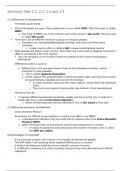Summary Geo 2.1, 2.2, 2.3 and 2.4
2.1 Differences in development
The North-south divide
75% of all people are poor, these people live in a so called LEDC. The richer part is called
MEDC.
o The most of MEDC are in the northern part of the world or the north. The poor part
is called the south.
There are a lot of different words for a group of rich/poor people.
o Examples are: Developed/developing countries, first world and third world
countries.
A poor country often is called a NIC a newly industrialising country.
When people talk about a poor country, they often use a word with a negative connection,
LEDC is considered a bit more neutral.
You can recognise a rich or poor country by looking at the houses and people’s
belongings.
Differences within a country
Differences in rich and poor doesn’t have to exist between countries, within
countries it’s also possible.
o This is called regional disparities.
o In the regions that perform better citizens are better paid, and they have access
to supermarkets, hospitals and schools for example.
In most countries, these are the urban regions, where there are important
cities.
The more rural regions (countryside) stay behind in their development.
Moving to the city
If regional differences become too strong, people will move to the city, in hope for a
better life, this is called rural-urban migration.
o Some of them stay poor and are doomed to live in the slums of that city.
2.2 Measuring economic development.
Gross Domestic Product
- Sometimes it’s difficult to say whether a country is an LEDC or an MEDC.
o A development indicator that you could use to measure this is the Gross Domestic
Product (GDP).
o GDP is the total value of all products and services produced by a country.
It’s fairer to divide the total amount by the number of citizens, this is called
the GDP per capita.
Disadvantages of using GDP
- It’s an average number, the income is not equally divided by the people.
- The GDP doesn’t tell anything about regional differences in a country.
- It doesn’t tell what you could buy from a specific amount of money.
- It is difficult to measure it in some countries, because they have jobs that aren’t official
registered.
, Economic employment sectors.
Primary sector: People own their money by working in agriculture, mining, forestry or fishing.
In their jobs they make use of raw materials. The product is inexpensive, the salary is low and
the percentage of people working in the primary sector is much higher in LEDCs than in MEDCs.
Secondary sector: People own their money by working in a factory, they manufacture all kinds
of products, they often use raw materials as input. It’s often better paid than primary sector jobs,
the amount of people work in the factory has increased in LEDCs and decreased in MEDCs.
Tertiary sector: People own their money by giving a service to someone else, like a teacher,
hairdresser or nurse. Most people in MEDCs work in this sector, MEDCs has a low percentage of
people that officially work in this sector. The sector of people who work unofficial is called the
informal sector.
2.3 Measuring human development.
Basic necessities.
- How do you check if someone lives in wealth?
o Easy way is to look if he has access to basic necessities.
Food, water, clothing and shelter
Also access to sanitation, education and healthcare.
- People who don’t have these are considered poor.
o They come in the poverty trap.
No income = no food = becoming ill = aren’t able to work.
Human development indicators.
- In order to check poverty and wealth, we can look at human development indicators.
o Is the process of increasing people’s freedoms and opportunities, and improving
their well-being.
o Indicators are infant mortality rate, literacy rate, distribution of medical doctors and
life expectancy.
- If people in a certain country have no access to the basic necessities, this will have a
negative effect on the overall development of that country.
Infant mortality rate, literacy rate, physician distribution and life expectancy.
- Young children will die in a country without good hygiene and enough food.
o The number of children who die under the age of one is called the infant mortality
rate.
Higher in LEDCs than MEDCs.
o If you want to look at the development of a country, you look at the literacy rate.
This shows how many people can read and write, higher in MEDCs than
LEDCs.
o Physician distribution shows how many people must share one doctor.
Higher in MEDCs than LEDCs.
o Life expectancy shows on average how old people become in a country.
Human development index (HDI)
- Human development index (HDI) shows the overall level of development in a country.
o Combines the economic and human development in one number.





